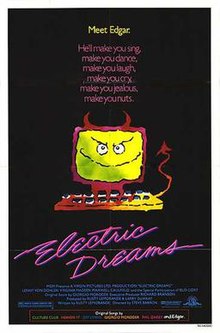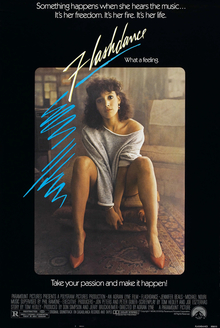
Flashdance is a 1983 American romantic drama dance film directed by Adrian Lyne and starring Jennifer Beals as a passionate young dancer who aspires to become a professional ballerina (Alex), alongside Michael Nouri playing her boyfriend and the owner of the steel mill where she works by day in Pittsburgh. It was the first collaboration of producers Don Simpson and Jerry Bruckheimer, and the presentation of some sequences in the style of music videos was an influence on other 1980s films including Footloose, Purple Rain, and Top Gun, Simpson and Bruckheimer's most famous production. It was also one of Lyne's first major film releases, building on television commercials. Alex's elaborate dance sequences were shot using body doubles.

Giovanni Giorgio Moroder is an Italian composer and music producer. Dubbed the "Father of Disco", Moroder is credited with pioneering euro disco and electronic dance music. His work with synthesizers had a large influence on several music genres such as Hi-NRG, Italo disco, synth-pop, new wave, house and techno music.
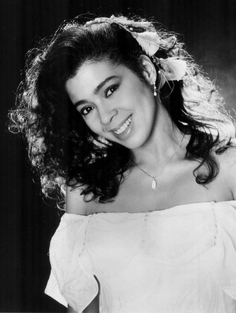
Irene Cara Escalera was an American singer and actress who rose to prominence for her role as Coco Hernandez in the 1980 musical film Fame, and for recording the film's title song "Fame", which reached No. 1 in several countries. In 1983, Cara co-wrote and sang the song "Flashdance... What a Feeling", for which she shared an Academy Award for Best Original Song and won a Grammy Award for Best Female Pop Vocal Performance in 1984.

Philip Oakey is an English singer, songwriter and record producer. He is the lead singer, songwriter, and co-founder of the synth-pop band the Human League. Aside from the Human League, Oakey has enjoyed an extensive solo music career and has collaborated with numerous other artists and producers.

"Flashdance... What a Feeling" is a song from the 1983 film Flashdance with music by Giorgio Moroder and lyrics by Keith Forsey and the song's performer, Irene Cara. Moroder had been asked to score the film, and Cara and Forsey wrote most of the lyrics after they were shown the last scene from it in which the main character dances at an audition for a group of judges. They felt that the dancer's ambition to succeed could act as a metaphor for achieving any dream a person has and wrote lyrics that described what it feels like when music inspires someone to dance. The song wound up being used for the scene they watched as well as during the opening credits as the main character is shown working as a welder.

Thomas Ross Whitlock was an American songwriter, best known for co-writing the Academy Award– and Golden Globe–winning song "Take My Breath Away", performed by Berlin from the film Top Gun, with Giorgio Moroder. He wrote another song for the film, "Danger Zone", performed by Kenny Loggins.
Leonard Harold Von Dohlen IV was an American television, film, and stage actor. With a 40-year career that primarily featured work in independent films and guest appearances on numerous prominent series, he was probably best known for his performance as architect Miles Harding in the film Electric Dreams (1984), the title role as a steelworker's son opposite Karl Malden in Billy Galvin (1986), and as the orchid-loving agoraphobe Harold Smith in the television series Twin Peaks and its prequel film Twin Peaks: Fire Walk with Me.
Paul Engemann is an American former pop singer. He is best known for performing vocals on the 1983 Giorgio Moroder song "Scarface ", which was featured prominently in the film Scarface.

Greatest Hits is a compilation album by the English synth-pop band The Human League, released on 31 October 1988 by Virgin Records. It contains 13 singles released by the band, spanning from their debut single to their most recent album at the time, as well as lead singer Philip Oakey's collaboration with Giorgio Moroder, "Together in Electric Dreams" (1984). The album reached No. 3 in the UK.
Joe "Bean" Esposito is an American singer-songwriter whose career spans from the 1970s to the present day. Esposito is known for creating songs that have appeared in film soundtracks, such as those of American Hot Wax, Staying Alive, Scarface, The Karate Kid, and Coming to America. Several of his songs have also been recorded by Donna Summer, Aretha Franklin, Patti LaBelle, and Stephen Stills, among others.
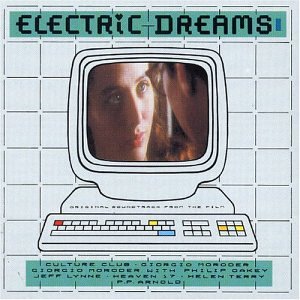
Electric Dreams is a soundtrack album from the film Electric Dreams, released in 1984.

Scarface: Music from the Original Motion Picture Soundtrack is the soundtrack album featured on the 1983 American crime film, Scarface, which was directed by Brian De Palma. Composed by Italian producer Giorgio Moroder, the vinyl soundtrack was released on December 9 of the same year through MCA Records. The album features music created by Moroder, who wrote and produced all of the tracks. Scarface counts with the collaboration of multiple singers, including Paul Engemann, Debbie Harry, Amy Holland, Elizabeth Daily, among other artists. The soundtrack received a Golden Globe Award nomination for Best Original Score at the 41st Golden Globe Awards.
Helen St. John is a singer-songwriter, pianist, lyricist and recording artist.
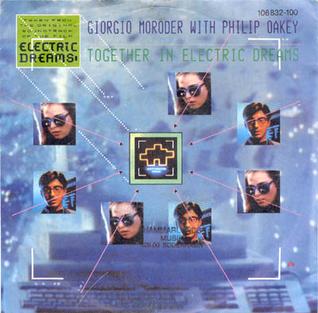
"Together in Electric Dreams" is a song by the British singer and composer Philip Oakey and Italian composer and producer Giorgio Moroder. It was written by Oakey and Moroder and recorded for the original soundtrack of the film Electric Dreams (1984). It later formed part of the joint album Philip Oakey & Giorgio Moroder, released in 1985.

What a Feelin' is the second studio album by American singer-songwriter Irene Cara. Released on November 2, 1983, this album is a continuation of the work that Cara began with producer Giorgio Moroder on the soundtrack to the 1983 film Flashdance. The dance-pop song she co-wrote with Moroder and Keith Forsey for the film, "Flashdance... What a Feeling", went to number one on Billboard magazine's Hot 100 and foreshadowed the style of this album, which was unlike her R&B-heavy debut. Although Cara was more accustomed to composing music, she relinquished most of those duties to Moroder here and shifted much of her songwriting focus to lyrics.
Electric Dreams may refer to:
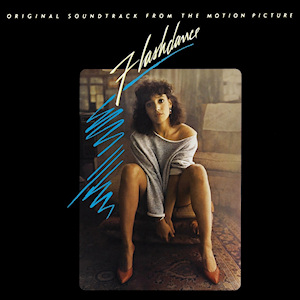
Flashdance: Original Soundtrack from the Motion Picture is the soundtrack to the 1983 film Flashdance, which tells the story of Alex Owens, a welder and exotic dancer who dreams of becoming a professional ballerina. The nightclub performances by Alex and her co-workers and other set pieces involving training and auditioning provided opportunities to present the songs that would make up the soundtrack album. The film's music supervisor, Phil Ramone, made selections that he felt were the best fit for their respective scenes, and composer Giorgio Moroder contributed additional tracks in the process of scoring the film. One of his contributions, "Flashdance...What a Feeling" by Irene Cara, was released as a single in March 1983, weeks before the film's April 15 release, and eventually spent six weeks at number one on the Billboard Hot 100. The soundtrack was released on April 11, 1983 by Casablanca Records.

"Good-Bye Bad Times" is a song by British singer and songwriter Philip Oakey and Italian producer Giorgio Moroder. It was written by Oakey and Moroder and recorded for the album Philip Oakey & Giorgio Moroder. Released as a single in the UK in June 1985 as the follow-up to Oakey and Moroder's 1984 hit "Together in Electric Dreams", it reached number 44 on the singles charts and remained on the charts for 5 weeks. It was moderately successful in Australia, where it peaked at number 26.

"The Dream (Hold On to Your Dream)" is a song written by Giorgio Moroder, Pete Bellotte, and the song's performer, Irene Cara, for the 1983 film D.C. Cab. Although not included on initial pressings of Cara's What a Feelin' LP, the decision to release the film four months earlier than originally slated prompted an arrangement for her album to be reissued with the song. A slightly different version (more noticeable in the intro) was also included on the film's soundtrack album; an edited version was released on the 7-inch single, and the 12-inch single included a much longer dance remix.
